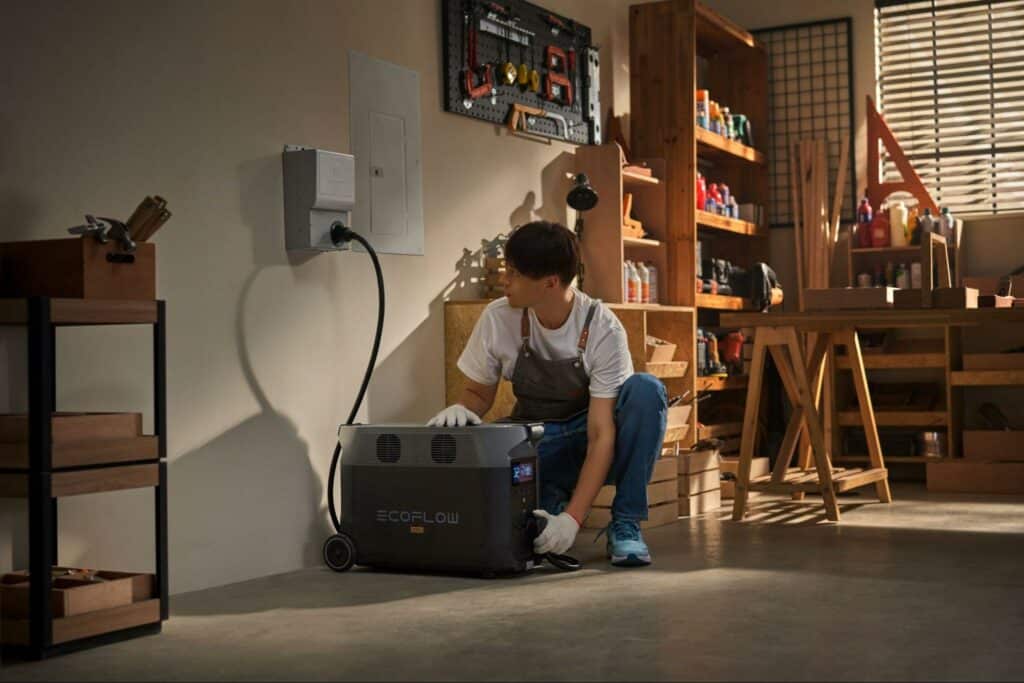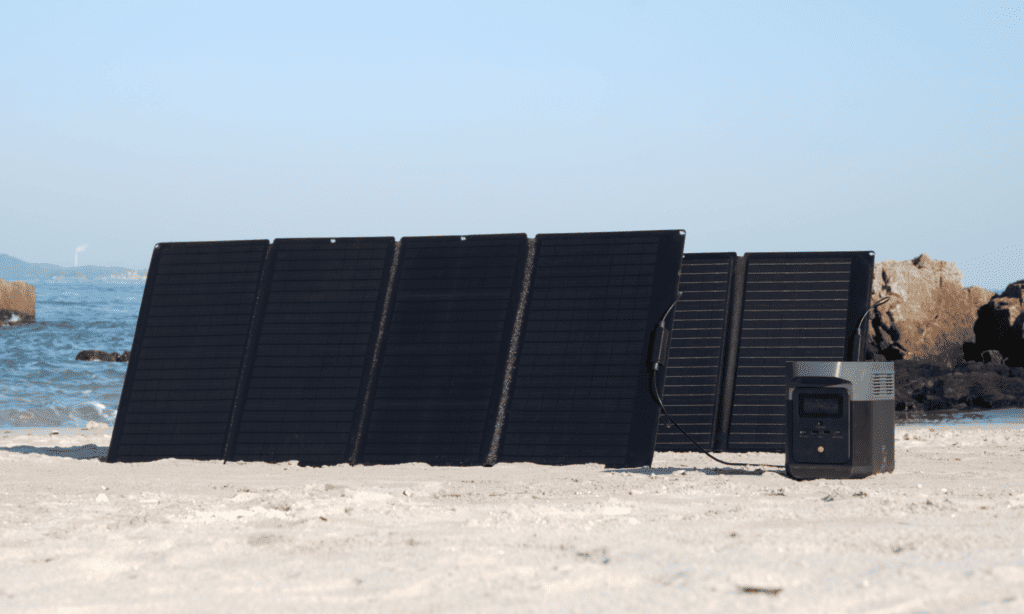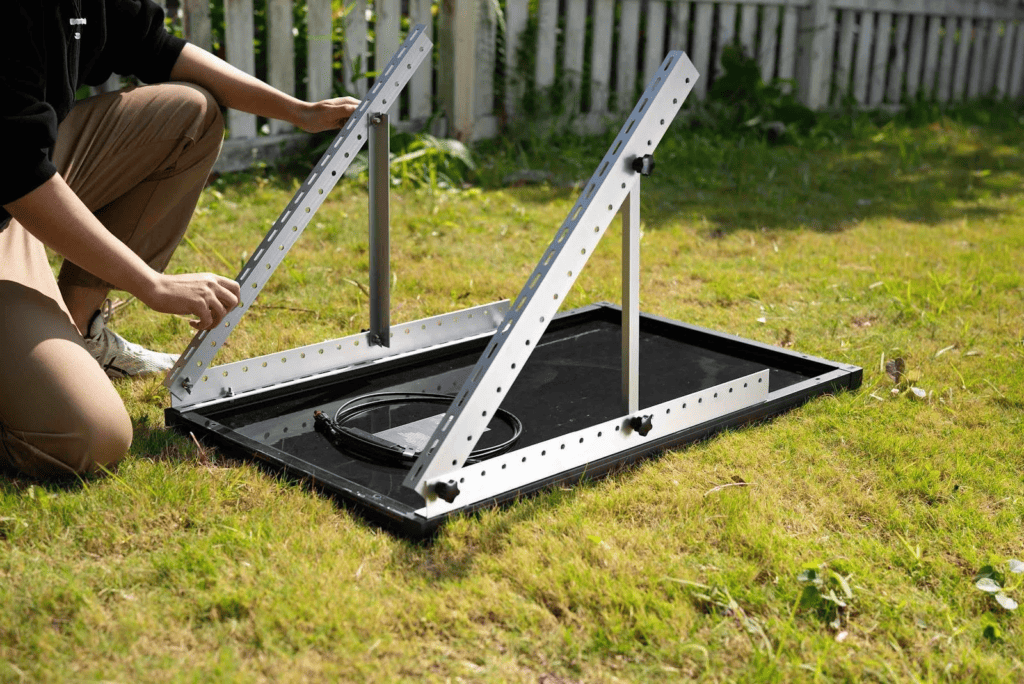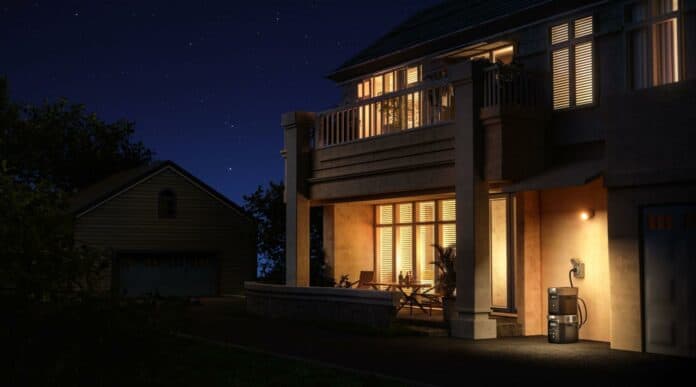Table of Contents
If you’ve spent any time researching home backup generators, you’ve probably heard of Generac.
Founded in 1959, Generac has long been a leading manufacturer of residential and commercial gas and diesel generators. In 2019, Generac launched its first solar-powered home backup product — PWRCell.
Generac doesn’t develop or manufacture solar panels. Instead, PWRCell provides an inverter and solar batteries that rely on third-party photovoltaic modules. It’s compatible with most modern PV panels, including those designed, developed, and manufactured by EcoFlow.
EcoFlow is the new kid on the block compared to Generac when it comes to providing Whole Home Generators and backup solutions.
Unlike Generac, EcoFlow is an award-winning solar-first innovator laser-focused on off-grid electricity generation and battery backup solutions.
How does EcoFlow’s Whole Home Generator stack up against Generac’s PWRCell?
You’re about to find out.

Why Do Home Generators Matter?
For many Americans, purchasing a home generator matters more than ever.
Thanks to a sharp increase in extreme weather events and electricity demand — coupled with aging energy infrastructure and rising fuel costs — energy insecurity is becoming a fact of life.
Generating your own electricity decreases (or eliminates) your reliance on the utility grid and ensures your home has power during a blackout.
For decades, fossil fuel generators — usually gas or diesel — were the only option for people seeking home generator solutions for backup power.
Thanks to solar-first manufacturers like EcoFlow, photovoltaic (PV) panel arrays, portable power stations, and Power Kits are now accessible to more homeowners than ever before. Using affordable high-efficiency solar panels with the above products or another balance of system provides a reliable — and sustainable — alternative to greenhouse gas emitting gas or diesel generators.
Residential solar power has become so popular in recent years that even long-established fossil fuel generator manufacturers like Generac have begun offering solar generators — including its modular PWRCell system.
Below, we’ll compare Generac’s PWRCell to EcoFlow’s Whole Home Generator solutions.
But before that — are home generators worth it in the first place?
Is It Worth Buying a Home Generator?
If you care about keeping your family safe in a power outage, a home generator is absolutely worth it.
If you ALSO care about the future of our planet, opt for a solar generator — not one fueled by gas, propane, or diesel.
Fossil fuel generators appear to be a much cheaper option when it comes to sticker price.
But with solar generators, there are no ongoing maintenance or fuel costs. Once your solar payback period is complete, all that money you save on electricity bills goes straight into your pocket.
Fossil fuel generators cost less upfront, but over the long term, your return on investment in solar pays off in dollars — and helps ensure the Earth’s future.
Advances in technology and economies of scale have made switching to solar more affordable than ever.
Couple that with never-before-seen federal, state, and local government incentives and tax credits, and there’s never been a better time to embrace clean, renewable solar electricity for your home.

Are Home Generators Sustainable?
Most home generators do NOT produce sustainable power.
Solar generators are skyrocketing in popularity, but traditional gas and diesel generators — like those Generac specializes in — still vastly outnumber renewable residential power solutions.
By choosing to go off-grid or back up your home using solar energy, you’re making a crucial contribution to making electricity generation greener and more sustainable.
And you won’t be alone.
Share of Cumulative Power Capacity by Technology, 2010-2027
(Source: IEA)
According to the International Energy Agency: “Solar PV’s installed power capacity is poised to surpass that of coal by 2027, becoming the largest (electricity source) in the world.”
Source: SEIA/Wood Mackenzie Power & Renewables U.S. Solar Market Insight Q3 2023
In the United States, the number of residential solar installations grew by 40% in 2022 over 2021, and that trend is expected to accelerate significantly in the foreseeable future.
Consumption of Primary Fossil Fuel Energy in the United States From 1990 to 2022 by Sector
(in trillion British Thermal Units)
(Source: Statista)
In 2022, electricity generation was second only to transportation as the largest fossil fuel consumer by sector. US electricity production required 21,577 trillion BTUs, and transportation required 25,910 trillion BTUs.
The transition to residential solar power must continue for the US to meet its net-zero goals and remain a leader in the global battle against climate change.
By switching your electricity production or home backup system to solar, you can significantly reduce your carbon footprint and invest in the future — to the benefit of your bank account AND the planet.
Generac’s Approach to Cleaner Energy
Generac was founded in 1959 and has long been a leading manufacturer of fossil fuel generators for home backup and commercial applications.
In 2019, Generac launched its first solar home backup product: PWRCell.
Although Generac doesn’t manufacture solar panels, PWRCell is compatible with most contemporary PV panels — like EcoFlow’s — that use universal solar connectors.
With more and more homeowners opting for renewable electricity sources instead of gas and diesel generators — both for home backup and to achieve greater energy independence — Generac’s foray into the booming residential solar power market makes good business sense…
But how does PWRCell compete against the Whole Home Generators offered by an award-winning solar-first innovator like EcoFlow?
Read on to find out.
Storage Capacity
Generac’s PWRCell is a modular residential solar power system that allows you to add battery storage capacity to meet your needs.
Each PWRCell system consists of Generac Battery Modules, Battery Cabinet(s), an Inverter, and third-party manufactured solar panels.
The minimum storage capacity is 9kWh using 3 x Battery Modules. You can increase storage capacity up to 18 kWh by adding additional Battery Modules to the Battery Cabinet. If 18kWh is insufficient, you have the option to add another battery cabinet and store up to 36kWh of electricity in total.
Generac’s Battery Modules use lithium nickel manganese cobalt oxide (NMC/Li-NMC) cathode chemistry. We’ll examine the benefits of lithium iron phosphate (LiFePO4/LFP) battery chemistry over NMC in the EcoFlow section below.
It’s crucial to note that NMC batteries have a lower depth of discharge (DoD) rate than LFP.
Depth of discharge indicates how much of a battery’s storage capacity you can expend before permanently damaging the pack’s cells. The recommended DoD for Generac’s Battery Modules is 84%.
Usable Storage Capacity for Generac PWRCell Batteries (Based on Recommended Depth of Discharge)
| PWRCell Configuration | Nominal Storage Capacity | Operating Capacity By DoD |
| M3 (3 x Battery Modules) | 9kWh | 7.56kWh |
| M4 (4 x Battery Modules) | 12kWh | 10.08kWh |
| M5 (5 x Battery Modules) | 15kWh | 12.6kWh |
| M6 (6 x Battery Modules) | 18kWh | 15.12kWh |
Following the recommended DoD, the 9kWh of storage provided by the base PWRCell system is reduced by 1.44kWh to an operating capacity of 7.56kWh. A full PWRCell Battery Cabinet containing six solar batteries nominally provides 18kWh of storage capacity. However, usable electricity storage without exceeding DoD recommendations is just 15.12kWh — almost 3kWh less than the top-line listed spec.
Household Electricity (AC) Output
PWRCell’s AC output capacity — which determines how many appliances you can run simultaneously — increases as you expand your storage capacity.
However, PWRCell’s AC output specs also come with a caveat.
To understand why, it’s essential to grasp the difference between starting and running watts.
Many high-wattage appliances — especially those that rely on motors to operate, like refrigerators and washing machines — require significantly more power to start up than to run. The initial burst of electricity needed to turn on these devices is called surge power or starting watts.
Unlike the portable power stations at the heart of EcoFlow’s Whole Home Generator solutions, Generac lists PWRCell’s starting wattage first.
For example, a PWRCell with three Battery Modules can only provide 3.4kW of running wattage and 4.5kW starting watts. In contrast, EcoFlow DELTA Pro provides 3.6kW of running watts and 7.2kW starting wattage.
Make sure to take the starting wattage of the appliances you want to operate into account when totaling your household electricity consumption — especially if you plan on going off-grid.
Generac PWRCell — Running and Starting Wattage by Configuration
| PWRCell Configuration | Operating AC Output (Running Watts) | Surge Power AC Output (Starting Watts) |
| M3 (3 x Battery Modules) | 3.4kW | 4.5kW |
| M4 (4 x Battery Modules) | 4.5kW | 6kW |
| M5 (5 x Battery Modules) | 5.6kW | 7.5kW |
| M6 (6 x Battery Modules) | 6.7kW | 9kW |
Grid-Tied Functionality
Unlike EcoFlow’s Whole Home Generator solutions, Generac’s PWRCell is designed primarily as an on-grid solar power solution. Only one of the five operating modes — Self Supply — takes you entirely off-grid.
The other five modes — Clean Backup, Priority Backup, Self Supply, Grid Tie, and Sell — all rely on being tied to the utility grid to varying degrees.
Grid-tied systems automatically switch between the electricity your solar panels capture and power from the grid. With PWRCell, you have the option to select the parameters under which your home draws power from the grid.
There are advantages to on-grid tied systems — particularly if you live in a location where the electricity grid is reliable. Renewable power sources like wind and solar are intermittent. Solar panels don’t capture energy from the sun at night.
On overcast, cloudy days, PV panels still capture photons from ambient sunlight using the photovoltaic effect. However, your solar panels will generate significantly less power than during peak sunlight.
Environmental conditions like cloud cover, temperature, and shade are among the most common reasons solar panels don’t always produce their rated power.
By automatically alternating between on-grid and solar power when necessary, intermittency isn’t an issue — as long as the utility grid is functioning. In fact, many grid-tied residential solar power systems don’t even use solar batteries. With the grid up and running, batteries are optional.
PWRCell functions both on and off the grid by switching between stored solar electricity and utility power under the parameters you set. If you choose Clean Backup mode, PWRCell should ensure that your solar batteries are always topped up in case of a blackout.

(Source: SEIA)
Net Metering
Depending on where you live — and your utility provider — you may have the option to sell the electricity you generate in excess of what you consume back to the grid.
If your utility company does offer net metering — and in many states, they’re required to — you will likely be outfitted with a smart electricity meter. Smart meters actually run backward when you produce more electricity than you consume. Electricity is automatically sent back to the grid and credited to your account in real-time.
On the off chance that you generate more electricity than you use during a month, you will receive a credit balance on your utility bill. Most companies will issue a payment for a credit balance if you request it.
PWRCell even offers a Sell mode designed for people who want to sell ALL the electricity their solar power system generates back to the grid. If you’re looking to make money by generating electricity, there are better options available. However, Sell mode could come in handy if you’re out of town for extended periods. Even if you’re not consuming the solar energy your system generates, you can put it to work for you by selling the electricity it produces to your utility company.
Ecoflow’s Vision: Beyond Traditional Power Generation
Since EcoFlow was founded by battery and solar industry veterans in 2017, it has established itself as an innovation leader in off-grid residential solar power and home backup solutions.
Its flagship product, EcoFlow DELTA Pro, was the most funded tech project of all time on Kickstarter and has won multiple design awards and a permanent place at the top of reviewer’s picks for best off-grid solar power systems.
EcoFlow doesn’t have decades of experience manufacturing fossil fuel generators like Generac does — and that has its benefits. Solar constitutes a fraction of Generac’s business: a handful of products in a massive line of residential and commercial gas and diesel burning generators.
EcoFlow’s focus has always been solar first. Unlike Generac, EcoFlow manufactures its own solar panels and offers complete residential backup and Whole Home Generator solutions.
Curious to find out more about what sets EcoFlow’s innovative products apart from traditional generator manufacturers like Generac?
Read on!

Off-Grid Energy Independence
Depending on your electricity generation goals, you may be perfectly happy with a grid-tied system. As outlined above, staying partially on-grid does offer several benefits.
However, if your goal is true energy independence, purchasing a whole home generator designed for off-grid use from the ground up is a superior option.
EcoFlow’s Whole Home Generator integrates seamlessly with your home’s existing wiring through the EcoFlow Smart Home Panel. You get unprecedented control and monitoring of up to 10 circuits that support multiple appliances with 15A, 20A, or 30A relay modules.
The EcoFlow smartphone app gives you complete control over your solar generator from anywhere with an internet signal.
With enough solar panels, AC output, and storage capacity, EcoFlow’s Whole Home Generator and Smart Home Ecosystem offers true electricity self-sufficiency.
Being truly grid-independent means no more worrying about electricity bills and rising fuel costs. It also substantially reduces your family’s carbon footprint.
Fast Charging With More Inputs
Just because EcoFlow’s Whole Home Generators and Power Kits are designed to operate without conventional electricity doesn’t mean you can’t AC power to charge them if you want to.
In fact, EcoFlow DELTA Pro — the heart of the system — offers more charging options than any other portable power station on the market.

MultiCharge delivers record-breaking recharge speeds with up to 6500W total input
Purchasing a Smart Extra Battery for your Whole Home Generator not only adds 3.6kWh of storage capacity, it also gives you access to EcoFlow’s proprietary multi charge technology.
In multicharge mode, you can achieve up to 6500W of simultaneous power input by combining 1600W of solar input, 1700W Smart Generator (Dual Fuel) input, and one of the following options:
- 3000W 240V AC Input
- 3400W EcoFlow Smart Home Panel
- 3400W EV Charger
With six charging inputs ( (Solar/AC/Car Charger/EcoFlow Smart Home Panel/Smart Generator Dual Fuel/EV Charge Station), going off-grid with EcoFlow DELTA Pro doesn’t give you fewer options — it gives you more.

Solar Battery Chemistry: LFP Vs. NMC
Lithium iron phosphate (LFP/LiFePO4) and lithium nickel manganese cobalt (NMC/Li-NMC) batteries are both relatively new variations on traditional lithium-ion (Li-ion) battery chemistry. Both offer numerous benefits over centuries-old rechargeable battery tech — like lead-acid and nickel-cadmium — and earlier generations of Li-ion batteries.
However, the LFP batteries in almost all of EcoFlow’s current products are superior to the NMC batteries in Generac’s PWRCell in numerous ways.
In short, LiFePO4 batteries beat out Li-NMC in all the performance metrics (and other factors) listed below:
- Cycle life (Longevity)
- Depth of discharge (DoD)
- Safety
- Sustainability
- Ethical sourcing
- Environmental impact
All-In-One Balance of System That’s Easy to Install
Generac’s PWRCell solar generator is comprised of at least four separate components:
- Inverter
- Battery Cabinet
- Battery Modules
- Third-party manufactured solar panels
Unlike EcoFlow’s Whole Home Generator, PWRCell needs a licensed electrician to install the required balance of system components.
EcoFlow’s portable power stations contain all required balance of system components in a compact all-in-one unit, including:
Just plug in EcoFlow’s rigid, portable, or flexible solar panels, and you’re good to go.
Unlike Generac. EcoFlow is a solar-first manufacturer that produces its own solar panels. Choosing a company that researches, designs, and develops its own solar panels and balance system components prevents compatibility issues and ensures you get the best technology available.

DIY Solar Panel Installation
EcoFlow’s flexible and portable solar panels don’t require fixed installation. If you choose, you can mount flexible solar panels without drilling a single hole using double-sided adhesive tape. Portable solar panels come with a kickstand and case included — you can set them up anywhere there’s sunlight.
Even with limited DIY experience, EcoFlow’s 100W and 400W rigid solar panels are easy to mount, even on a roof.
By mixing and matching rigid, flexible, and portable PV panels, you can maximize your available surface area that receives direct sunlight. Because all EcoFlow’s share plug-and-play compatibility, it’s simple to chain multiple panels of each construction together in series or parallel.
Not only are EcoFlow’s PV panels easy to install, but they also offer industry-leading efficiency — meaning you can produce more electricity while taking up less space.
The monocrystalline solar cells contained in each IP68-rated EcoFlow solar panel offer the best available performance in a durable construction that will last decades.
A True 5-Year Warranty
With a warranty period of ten years vs. five, PWRCell offers double the warranty period of EcoFlow’s Whole Home Generators.
However, Generac’s ten-year warranty comes with a crucial caveat.
PWRCell’s warranty lasts for ten years OR until 7.56mWh of electricity cycles through each Battery Module.
The average American household uses 10,632 kWh of electricity annually, or 10.632mWh. The minimum number of PWRCell solar battery modules is three.
3 x 7.56mWh = 22.68mWh
22.68mWh / 10.632mWh =
If you use PWRCell to run your house off-grid daily, your warranty could expire in just over two years.
If you use more electricity than the average American household, your warranty could end much sooner.
EcoFlow’s warranty on EcoFlow DELTA Pro and Smart Extra batteries is five years, regardless of how much electricity cycles through the system. There is no restriction on your usage during the warranty period — even if your generator works 24/7.
It’s essential to account for any usage restrictions with Li-on solar batteries. Unlike lead acid batteries, Li-ion battery subsets like NMC and LiFePO4 don’t degrade over time — they degrade with use.
If you use a solar generator only for occasional home backup, 7.56mWh of throughput may last ten years.
If your goal is to achieve energy independence and self-sufficiency off-grid, PWRCell’s warranty is unlikely to last you even three years — maybe less.
Part of the Growing EcoFlow Smart Home Ecosystem
Solar is a sideline for Generac.
Most of the company’s revenue comes from commercial and residential fossil fuel powered backup generators.
On the other hand, EcoFlow is an award-winning solar first innovator that’s constantly expanding its Smart Home Ecosystem.
EcoFlow has won multiple Red Dot Design Awards, including one in 2023 for its Blade Robotic Lawnmower. One of a growing collection of Smart Devices, EcoFlow BLADE joins the EcoFlow WAVE 2 Portable Air Conditioner and EcoFlow GLACIER Portable Refrigerator — named Best Portable Appliance by Popular Mechanics at CES 2023.
EcoFlow doesn’t have the lengthy fossil-fueled past of Generac…
Instead, it’s a solar-first innovator that never stops designing for the future.
Generac PWRCell vs. EcoFlow Whole Home Generator: The Specs
| Specifications | Generac PWRCell | EcoFlow Whole Home Generator |
| Storage Capacity (Minimum) | 9kWh | 3.6kWh |
| Storage Capacity (Maximum) | 36kWh (2 Battery Cabinets at 18kWh each) | 25kWh |
| AC Output (Minimum) | 3.4kW Continuous output (4.5kW Surge) | 3.6kW Continuous output (7.2kW Surge) |
| AC Output (Maximum) | 6.7kW Continuous output (9kW Surge) | 7.2kW Continuous output (14.4 Surge) |
| Solar Charge Capacity (Maximum) | 15kW (38 x 400W PV Panels) | 3.2kW with 2 x EcoFlow DELTA Pro (16 x 400W PV Panels) |
| Charging Options | 2 (Solar/AC) | 5 (Solar/AC/Car Charger/EcoFlow Smart Home Panel/EV Charge Station) |
| Battery Chemistry | Lithium Nickel Manganese Cobalt (NMC) | Lithium Iron Phosphate (LFP/LiFePO4) |
| Depth of Discharge | 84% | 100% |
| Fossil Fuel Generator Cross-Compatibility | Yes | Yes (Smart Generator Dual Fuel) |
| Grid Tied/Off-Grid? | Yes | Off-grid only |
| Uninterruptible Power Supply (UPS) | Yes | Yes |
| Expandable? | Yes | Yes |
| Plug and Play Installation? | No | Yes |
| Proprietary Solar Panels? | No | Yes – Rigid, portable, and flexible monocrystalline PV panels (60W – 400W rated power) |
| Warranty (Per Solar Battery or Portable Power Station) | 10 years (or 7.56 MWh throughput per battery module) | 5 years (no cycle life restrictions) |
| App Monitoring and Control? | Yes | Yes |
| Federal Solar Tax Credit Eligibility? | Yes | Yes |
Frequently Asked Questions
EcoFlow’s solar generators provide the freedom to produce all (or part) of the electricity your home needs off-grid. Next to transportation, electricity generation consumes more fossil fuels than any other industry. Utilities have made progress in switching to renewable energy sources like wind and solar but still rely on burning coal, petroleum, and natural gas to produce sufficient electricity to feed the grid. The more homeowners that adopt solar, the faster America’s carbon footprint is reduced.
One strength of EcoFlow’s solar generators is their numerous charging options. EcoFlow DELTA Pro offers six: Solar, AC, DC car adapter, EcoFlow Smart Home Panel, Smart Generator Dual Fuel, and EV charging station. Combine solar with several of the options above in multicharge mode for up to 6500W of input and recharge your whole home generator in under 2 hours. Using solar only, EcoFlow DELTA Pro can recharge from 0-100% in about four hours using 4 x 400W rigid solar panels.
Generac’s PWRCell is designed primarily for grid-tied use. If the electricity you generate from solar isn’t sufficient for your needs, PWRCell automatically switches over to power from the utility grid. With an on-grid system, you can operate PWRCell without using energy captured by PV panels. But if you’re not going to generate a significant portion of your home’s electricity using solar power, purchasing a PWRCell makes little sense.
Final Thoughts
Switching all or part of your household’s electricity consumption to a renewable energy source is not only a wise investment from a financial perspective…
It’s an investment in the future.
Embracing clean electricity generation solutions like solar is essential to reducing the greenhouse gas emissions primarily responsible for human-made climate change.
By going fully off-grid with EcoFlow’s Whole Home Generator, you can achieve personal energy independence and virtually eliminate your carbon footprint from electricity consumption — the second biggest source of greenhouse gas emissions in the US.
Check out EcoFlow’s solar-first off-grid electricity solutions today.
